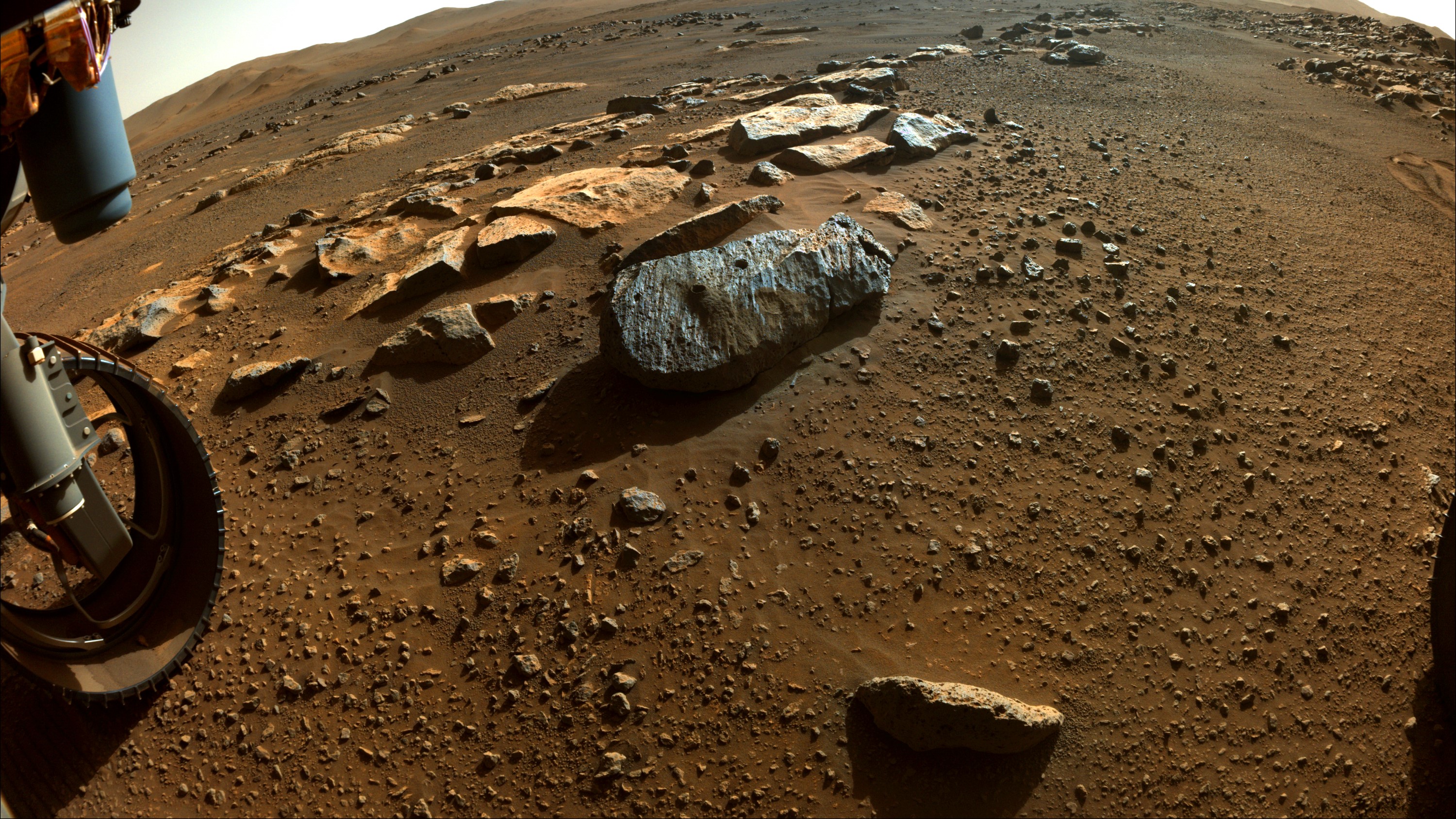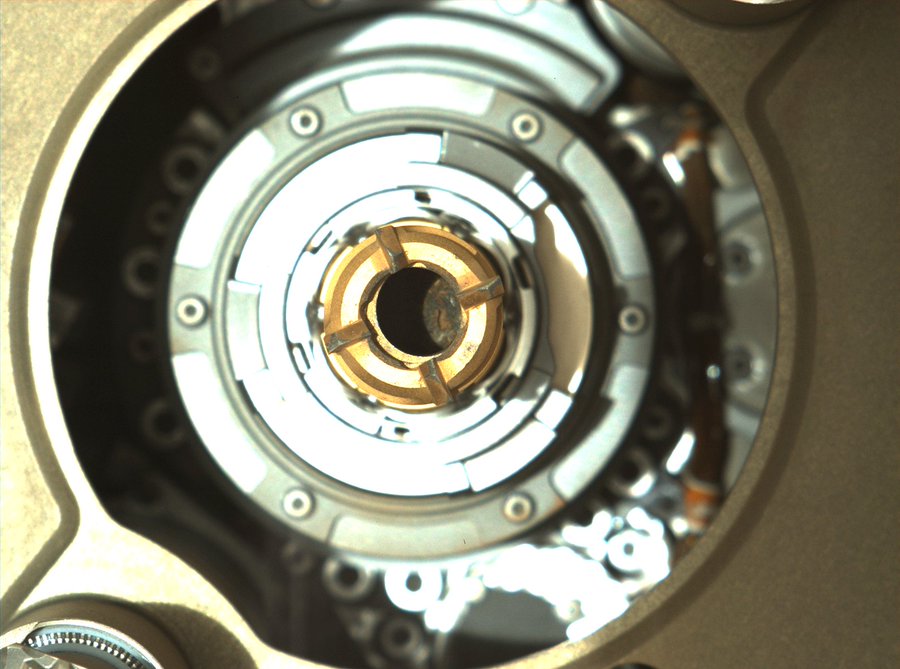NASA's Perseverance rover has taken the 1st steps in decades-long dream of Mars sample return
Perseverance's Mars rock samples may even hide salt crystal time capsules.

NASA's Perseverance rover on Mars has begun its out-of-this-world rock collection.
The rover, which is designed to search for signs of ancient life on Mars and to package up material for a future sample-return mission, made its first two successful sampling maneuvers on Monday and Wednesday (Sept. 6 and Sept. 8). NASA scientists describing the collection said they're thrilled with what they know so far about the two rock cores.
"This is a truly historic achievement, the very first rock cores collected on another terrestrial planet — it's amazing," Meenakshi Wadhwa, Mars sample return principal scientist, at NASA's Jet Propulsion Laboratory (JPL) in California and Arizona State University, said during a news conference held Friday (Sept. 10).
Related: Where to find the latest Mars photos from NASA's Perseverance rover
"In our science community, we've talked about Mars sample return for decades, and now it's actually starting to feel real," Wadhwa added. "These first core samples will actually be among tens of other samples that will be collected by the Perseverance rover."
This week's successes came after an initial sampling attempt a month prior didn't go quite according to plan. On Aug. 6, the Perseverance rover drilled into a carefully selected rock, but failed to cache a rock core. Scientists troubleshooting the issue determined that the rock was unexpectedly crumbly, foiling the rover's sampling mechanism.
At that point, the mission team's top priority was to confirm that the sampling mechanism was working properly. After analyzing the initial failure, Perseverance personnel pointed the rover to a new target that appeared to be less weathered and more robust, Jessica Samuels, the Perseverance surface mission manager at JPL, said during the news conference.
Get the Space.com Newsletter
Breaking space news, the latest updates on rocket launches, skywatching events and more!
And the rover team's second rock selection, nicknamed "Rochette," proved more amenable to Perseverance's equipment. In the meantime, the engineers' excitement had spilled over to the geologists on the team. "As we were evaluating this target, the science team found this target to be of very high value as well," Samuels said.
As a result, the mission team decided to attempt to collect not one but two samples of Rochette, which the team is now referring to as "Montdenier" and "Montagnac." Perseverance is equipped with 43 sample tubes, and because the rover will set up one or more stores of tubes during its mission, scientists have budgeted for taking multiple cores of rocks that they want to be positive can make it back to Earth, Perseverance deputy scientist Katie Stack Morgan of JPL said during the news conference.
Because of the previous sampling misfire, Perseverance's human directors had the robot take extra photographs before attempting to store the first sample, Montdenier, adding to the uncertainty.
Related: Photo tour of Jezero Crater: Here's where Perseverance will land on Mars

"We were rewarded for our patience," Matt Robinson, Perseverance strategic sampling operations team chief at JPL, said during the news conference, sharing an image. "Looking down the drill bit into the tube, you see a beautiful core there. At that point, our team was just absolutely ecstatic. I don't have words to say how we felt."
The scientists are ecstatic, too, of course. Both of the new samples come from the same boulder within Jezero Crater, where the rover is exploring terrain that long ago hosted a lake. That rock is likely relatively young, and so far, scientists have determined that that rock is basaltic, which means it may represent cooled lava that flowed along the Red Planet's surface. In addition, Perseverance has detected salt in the two cores.
These compounds could have formed from groundwater flowing through the rock or surface water evaporating away, according to a NASA statement. In addition, the salt might have locked away tiny bubbles of water as the crystal formed, according to the statement, which scientists may eventually be able to study as a sort of time capsule within the rock.
Since landing on the Red Planet in February, the Perseverance rover has spent nearly 200 Martian days (a little more than 200 Earth days) on the surface and has traveled about 1.4 miles (2.2 kilometers), Samuels said. However, because of Mars solar conjunction, when the sun comes between Earth and Mars and makes communication with the Red Planet difficult, Perseverance and the rest of NASA's Mars fleet will pause work for several weeks beginning by early October, according to NASA.
But even as the humans behind Perseverance celebrate the two new samples and prepare for a science hiatus, they are also planning the rover's next moves.
Perseverance is headed to a region scientists are calling South Séítah, which the rover's airborne companion, the Ingenuity helicopter, has been scouting out on reconnaissance flights. Mission scientists are intrigued by the region's rugged landscape of ridges, sand dunes and rock shards, and the rock here is likely older than Rochette, according to NASA.
The mission hopes to spend its time on Mars laying the groundwork for a future multispacecraft mission that NASA and the European Space Agency have begun developing to bring scientists their first pristine pieces of the Red Planet, perhaps by 2031. The sample collection is a milestone for not just Perseverance, but the agency's Mars program writ broad, Lori Glaze, the head of NASA's Planetary Science Division, said during the news conference.
And Perseverance also looks back, building on NASA's decades of experience exploring Mars, she emphasized. "Everything we do builds on what we've learned before," Glaze said. "We stand on the shoulders of the giants to be where we are today."
Email Meghan Bartels at mbartels@space.com or follow her on Twitter @meghanbartels. Follow us on Twitter @Spacedotcom and on Facebook.
Join our Space Forums to keep talking space on the latest missions, night sky and more! And if you have a news tip, correction or comment, let us know at: community@space.com.

Meghan is a senior writer at Space.com and has more than five years' experience as a science journalist based in New York City. She joined Space.com in July 2018, with previous writing published in outlets including Newsweek and Audubon. Meghan earned an MA in science journalism from New York University and a BA in classics from Georgetown University, and in her free time she enjoys reading and visiting museums. Follow her on Twitter at @meghanbartels.









